Minimization of the Environmental Emissions of Closed-Loop Supply Chains: A Case Study of Returnable Transport Assets Management
Abstract
:1. Introduction
2. Literature Analysis
3. Case Study
4. Modelling Framework
4.1. Computation of the Environmental Emissions
4.2. Environmental Key Performance Indicators
- (1)
- Total impact of retrieving for emissions of type e :
- (2)
- Total impact of shipments for emissions of type e :
- (3)
- Total impact of purchase for emissions of type e :
- (4)
- Total impact of lost and damaged pallets :
- (5)
- Total environmental impact of the CLSC for emissions of type e (, computed by adding up the contributions listed above, as follows:
4.3. Strategic and Economic Performance
- (1)
- The amount of proprietary assets , which reflects the average number of pallets owned by Company A and is expressed in (pallets);
- (2)
- Asset rotation , i.e., the number of times per year that the pallet stock rotates. It is expressed in (year−1);
- (3)
- Pallet utilization rate , computed as the ratio between the time (days) of real usage of the asset in the CLSC, either at the delivery point or in transportation activities, and its cycle time (days), which measures the time required for an asset to complete a cycle in the CLSC considered (i.e., from Company A to the customer and back to Company A);
- (4)
- Out of stock , which provides a quantitative measure of those critical situations where Company A does not have pallets available to ship products to its customer (days/year).
4.4. Input Data
4.5. Software Implementation
5. Optimization and Ranking Procedures
5.1. Optimization Procedure
- minimize the emissions of the system;
- minimize the occurrence of out-of-stock situations;
- maximize the use of assets;
- maximize the number of rotations of assets.
5.2. Ranking Procedure
- 0.25 for all the KPIs. This scenario should capture the situation where Company A attributes the same importance to all KPIs considered in the optimization;
- 0.40 for and and 0.10 for the total environmental impact and for the . This scenario should capture the situation where Company A attributes the highest importance to the strategic KPIs, while the environmental impact is perceived as less important.
6. Results
6.1. Simulation Results
6.2. Multi-Criteria Ranking
6.3. Sensitivity Analysis
7. Conclusions
Acknowledgments
Author Contributions
Conflicts of Interest
References
- Guide, V.-R.J.; van Wassenhove, L.-N. The evolution of closed-loop supply chain research. Oper. Res. 2009, 57, 10–18. [Google Scholar] [CrossRef]
- Govindan, K.; Soleimani, H.; Kannan, D. Reverse logistics and closed-loop supply chain: A comprehensive review. Eur. J. Oper. Res. 2015, 240, 603–626. [Google Scholar] [CrossRef] [Green Version]
- Badurdeen, F.; Iyengar, D.; Goldsby, T.; Metta, H.; Gupta, S.; Jawahir, I. Extending total life-cycle thinking to sustainable supply chain design. Int. J. Prod. Lifecycle Manag. 2009, 4, 49–67. [Google Scholar] [CrossRef]
- Guide, V., Jr.; Jayaraman, V.; Linton, J. Building contingency planning for closed-loop supply chains with product recovery. J. Oper. Manag. 2003, 21, 259–279. [Google Scholar] [CrossRef]
- Dekker, R.; Inderfurth, K.; van Wassenhove, L.; Fleischmann, M. Reverse Logistics—Quantitative Models for Closed-Loop Supply Chains; Springer: Berlin, Germany, 2004. [Google Scholar]
- Flapper, S.; van Nunen, J.; van Wassenhove, L. Managing Closed-Loop Supply Chains; Springer: Berlin, Germany, 2005. [Google Scholar]
- Tibben-Lembke, R. Strategic use of the secondary market for retail consumer goods. Calif. Manag. Rev. 2004, 46, 90–104. [Google Scholar] [CrossRef]
- Jena, S.; Sarmah, S. Future aspect of acquisition management in closed-loop supply chain. Int. J. Sustain. Eng. 2016, 9, 266–276. [Google Scholar] [CrossRef]
- European Commission. BRIGDE WP09—Returnable Transport Items: The market for EPCglobal applications. 2007. Available online: HTTP://BRIDGE-PROJECT.EU/DATA/FILE/BRIDGE%20WP09%20RETURNABLE%20ASSETS%20MARKET%20ANALYSIS.PDF (accessed on 26 October 2016).
- ISO/IEC. ISO/IEC 15459-5: 2014 Information Technology—Automatic Identification and Data Capture Techniques—Unique Identification—Part 5: Individual Returnable Transport Items (RTIs). 2014. Available online: HTTP://WWW.ISO.ORG/ISO/HOME/STORE/CATALOGUE_ICS/CATALOGUE_DETAIL_ICS.HTM?CSNUMBER=54785 (accessed on 26 October 2016).
- Johansson, O.; Hellstrom, D. The effect of asset visibility on managing returnable transport items. Int. J. Phys. Distrib. Logist. Manag. 2007, 37, 799–815. [Google Scholar] [CrossRef]
- Alfonso-Lizarazo, E.; Montoya-Torres, J.; Gutiérrez-Franco, E. Modeling reverse logistics process in the agro-industrial sector: The case of the palm oil supply chain. Appl. Math. Model. 2013, 37, 9652–9664. [Google Scholar] [CrossRef]
- Kroon, L.; Vrijens, G. Returnable containers: An example of reverse logistics. Int. J. Phys. Distrib. Logist. Manag. 1995, 25, 56–68. [Google Scholar] [CrossRef] [Green Version]
- Carrasco-Gallego, R.; Ponce-Cueto, E.; Dekker, R. Closed-loop supply chains of reusable articles: A typology grounded on case studies. Int. J. Prod. Res. 2012, 50, 5582–5596. [Google Scholar] [CrossRef]
- Wang, Z.; Soleimani, H.; Kannan, D.; Xu, L. Advanced cross-entropy in closed-loop supply chain planning. J. Clean. Prod. 2016, 135, 201–213. [Google Scholar] [CrossRef]
- Xu, H.; Cao, E. Closed-loop supply chain network equilibrium model and its Newton method. Kybernetes 2016, 45, 393–410. [Google Scholar] [CrossRef]
- Wu, C.; Barnes, D. Partner selection for reverse logistics centres in green supply chains: A fuzzy artificial immune optimisation approach. Prod. Plan. Control. 2016, 27, 1356–1372. [Google Scholar] [CrossRef]
- Zhu, Q.; Sarkis, J.; Lai, K. Green supply chain management implications for ‘closing the loop’. Transp. Res. 2008, 44, 1–18. [Google Scholar] [CrossRef]
- Preuss, L. The Green Multiplier: A Study of Environmental Protection and the Supply Chain; Palgrave MacMillan: Basingstoke, UK, 2005. [Google Scholar]
- Kannan, G.; Noorul Haq, A.; Devika, M. Analysis of closed loop supply chain using genetic algorithm and particle swarm optimisation. Int. J. Prod. Res. 2009, 47, 1175–1200. [Google Scholar] [CrossRef]
- Rogers, D.; Tibben-Lembke, R. An examination of reverse logistics practices. J. Bus. Logist. 2001, 22, 129–148. [Google Scholar] [CrossRef]
- Stock, J.; Speh, T.; Shear, H. Many happy (product) returns. Harv. Bus. Rev. 2002, 80, 16–17. [Google Scholar]
- Sbihi, A.; Eglese, R. Combinatorial optimization and Green Logistics. 4OR A Q. J. Oper. Res. 2007, 5, 99–116. [Google Scholar] [CrossRef] [Green Version]
- Lambert, S.; Riopel, D.; Abdul-Kader, W. A reverse logistics decisions conceptual framework. Comput. Ind. Eng. 2011, 61, 561–581. [Google Scholar] [CrossRef]
- Bottani, E.; Montanari, R.; Rinaldi, M.; Vignali, G. Modeling and multi-objective optimization of closed loop supply chains: A case study. Comput. Ind. Eng. 2015, 87, 328–342. [Google Scholar] [CrossRef]
- Chen, A.; Wang, X.-P.; Chen, B.-J.; Li, W.-W. Research on methods of reverse logistic vendor selection under closed-loop supply chain. In Proceedings of the 14th International Conference on Management Science and Engineering (ICMSE07), Harbin, China, 20–22 August 2007; pp. 879–884. [Google Scholar]
- Ismail, M.; Ainaa, S.; Abdullah, Z.; Shaharudin, M.; Zailani, S. A reputation-based strategy towards sustainable services by third party logistics (3PLs) in closed-loop supply chains (CLSCs). In Proceedings of the 2nd International Symposium on Technology Management and Emerging Technologies (ISTMET 2015), Langkawi, Malaysia, 25–27 August 2015; pp. 442–447. [Google Scholar]
- Gallo, M.; Murino, T.; Santillo, L. Evaluating the impact of product eco-redesign on CLSC performances through a system dynamics approach. Int. J. Prod. Qual. Manag. 2016, 18, 191–209. [Google Scholar] [CrossRef]
- Talbot, S.; Lefebvre, E.; Lefebvre, L. Closed-loop supply chain activities and derived benefits in manufacturing SMEs. J. Manuf. Technol. Manag. 2007, 18, 627–658. [Google Scholar] [CrossRef]
- Georgiadis, P.; Besiou, M. Environmental and economical sustainability of WEEE closed-loop supply chains with recycling: A system dynamics analysis. Int. J. Adv. Manuf. Technol. 2010, 47, 475–493. [Google Scholar] [CrossRef]
- Gao, N.; Ryan, S. Closed-loop supply chain network design under carbon emission regulations. In Proceedings of the 61st Annual IIE Conference and Expo, Reno, NV, USA, 21–25 May 2011; pp. 3367–3374. [Google Scholar]
- Shi, W.; Min, K. A study of product weight and collection rate in closed-loop supply chains with recycling. IEEE Trans. Eng. Manag. 2013, 60, 409–423. [Google Scholar] [CrossRef]
- Hasanov, P.; Jaber, M.; Zanoni, S.; Zavanella, L. Closed-loop supply chain system with energy, transportation and waste disposal costs. Int. J. Sustain. Eng. 2013, 6, 352–358. [Google Scholar] [CrossRef]
- Chen, Y.; Wang, L.-C.; Chen, T.-L.; Wang, A.; Cheng, C.-Y. A multi-objective model for solar industry closed-loop supply chain by using particle swarm optimization. In Proceedings of the 24th International Conference on Flexible Automation and Intelligent Manufacturing (FAIM 2014), San Antonio, TX, USA, 20–23 May 2014; DEStech Publications, Inc.: Lancaster, PA, USA; pp. 459–466. [Google Scholar]
- Chen, Y.; Chan, F.; Chung, S. An integrated closed-loop supply chain model with location allocation problem and product recycling decisions. Int. J. Prod. Res. 2015, 53, 3120–3140. [Google Scholar] [CrossRef]
- Garg, K.; Kannan, D.; Diabat, A.; Jha, P. A multi-criteria optimization approach to manage environmental issues in closed loop supply chain network design. J. Clean. Prod. 2015, 100, 297–314. [Google Scholar] [CrossRef]
- Alimorandi, A.; Yussuf, R.; Ismail, N.; Zulkifli, N. Developing a fuzzy linear programming model for locating recovery facility in a closed loop supply chain. Int. J. Sustain. Eng. 2015, 8, 122–137. [Google Scholar] [CrossRef]
- Govindan, K.; Jha, P.; Garg, K. Product recovery optimization in closed-loop supply chain to improve sustainability in manufacturing. Int. J. Prod. Res. 2016, 54, 1463–1486. [Google Scholar] [CrossRef]
- Dutta, P.; Das, D.; Schultmann, F.; Fröhling, M. Design and planning of a closed-loop supply chain with three way recovery and buy-back offer. J. Clean. Prod. 2016, 135, 604–619. [Google Scholar] [CrossRef]
- Kim, S.H.; Yoon, S.G.; Chae, S.H.; Park, S. Economic and environmental optimization of a multi-site utility network for an industrial complex. J. Environ. Manag. 2010, 91, 690–705. [Google Scholar] [CrossRef] [PubMed]
- Eriksson, E.; Blinge, M.; Lovgren, G. Life cycle assessment of the road transport sector. Sci. Total Environ. 1996, 189/190, 69–76. [Google Scholar] [CrossRef]
- Muncrief, R. NOX Emissions from Heavy-Duty and Light-Duty Diesel Vehicles in the EU: Comparison of Real-World Performance and Current Type-Approval Requirements. 2010. Available online: HTTP://WWW.THEICCT.ORG/SITES/DEFAULT/FILES/PUBLICATIONS/EURO-VI-VERSUS-6_ICCT_BRIEFING_06012017.PDF (accessed on 5 December 2017).
- United States Environmental Protection Agency (EPA). Overview of the Human Health and Environmental Effects of Power Generation: Focus on Sulfur Dioxide (SO2), Nitrogen Oxides (NOx) and Mercury (Hg). 2002. Available online: HTTPS://ARCHIVE.EPA.GOV/CLEARSKIES/WEB/PDF/OVERVIEW.PDF (accessed on 15 January 2018).
- Carraro, A.L.; Thorn, B.K.; Woltag, H. Characterizing the carbon footprint of wood pallet logistics. For. Prod. J. 2014, 64, 232–241. [Google Scholar]
- Harris, F. How many parts to make at once. Prod. Eng. 1913, 10, 135–136. [Google Scholar] [CrossRef]
- Infras. Handbook Emission Factors for Road Transport—HBEFA. 2010. Available online: HTTP://WWW.HBEFA.NET/E/HELP/HBEFA32_HELP_EN.PDF (accessed on 26 October 2016).
- Bertolini, M.; Bottani, E.; Vignali, G.; Volpi, A. Comparative life cycle assessment of packaging systems for extended shelf life milk. Packag. Technol. Sci. 2016, 29, 525–546. [Google Scholar] [CrossRef]
- Deb, K.; Pratap, A.; Agarwal, S. A fast and elitist multi objective genetic algorithm: NSGA-II. IEEE Trans. Evol. Comput. 2002, 6, 182–197. [Google Scholar] [CrossRef]
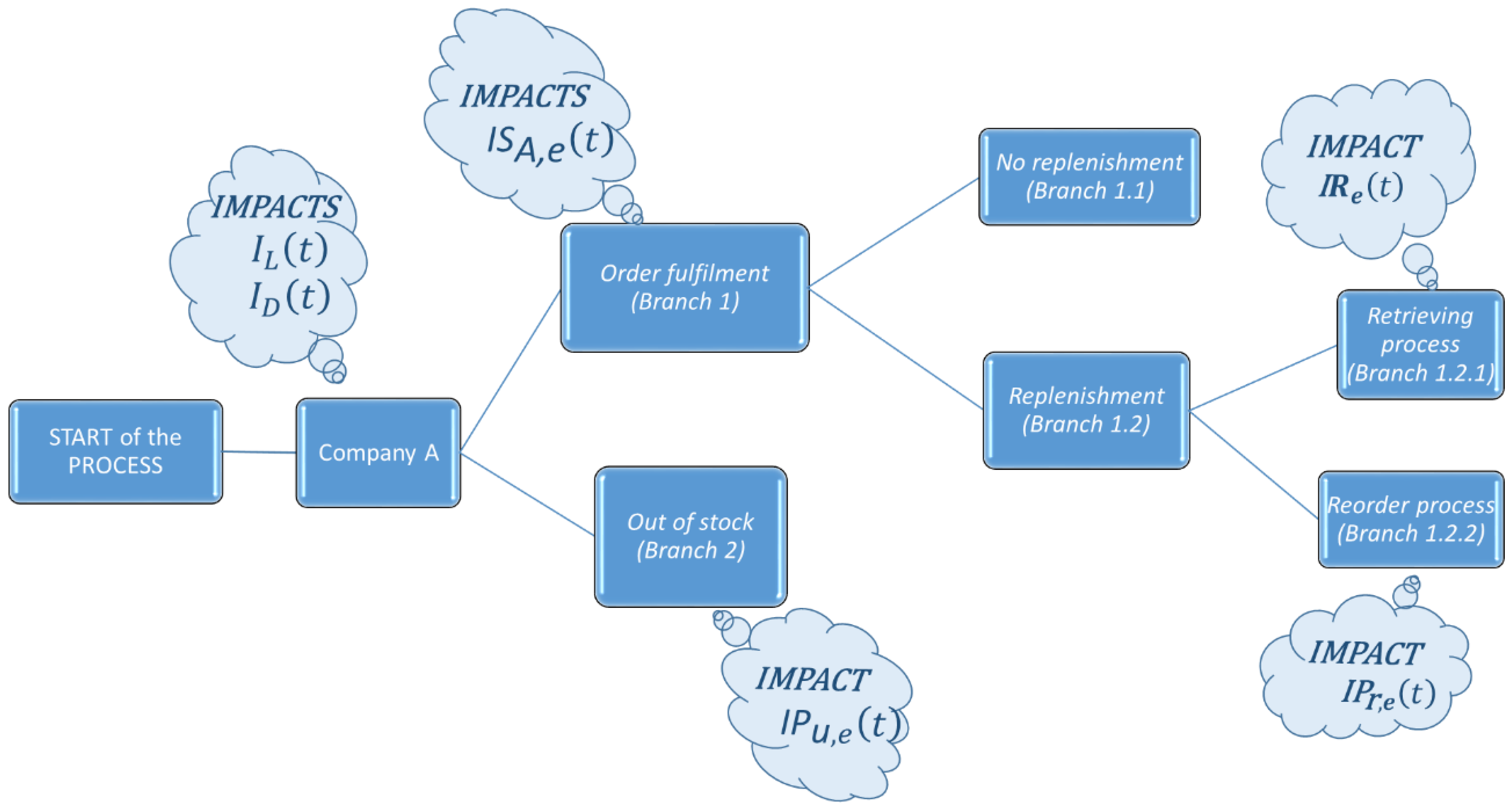
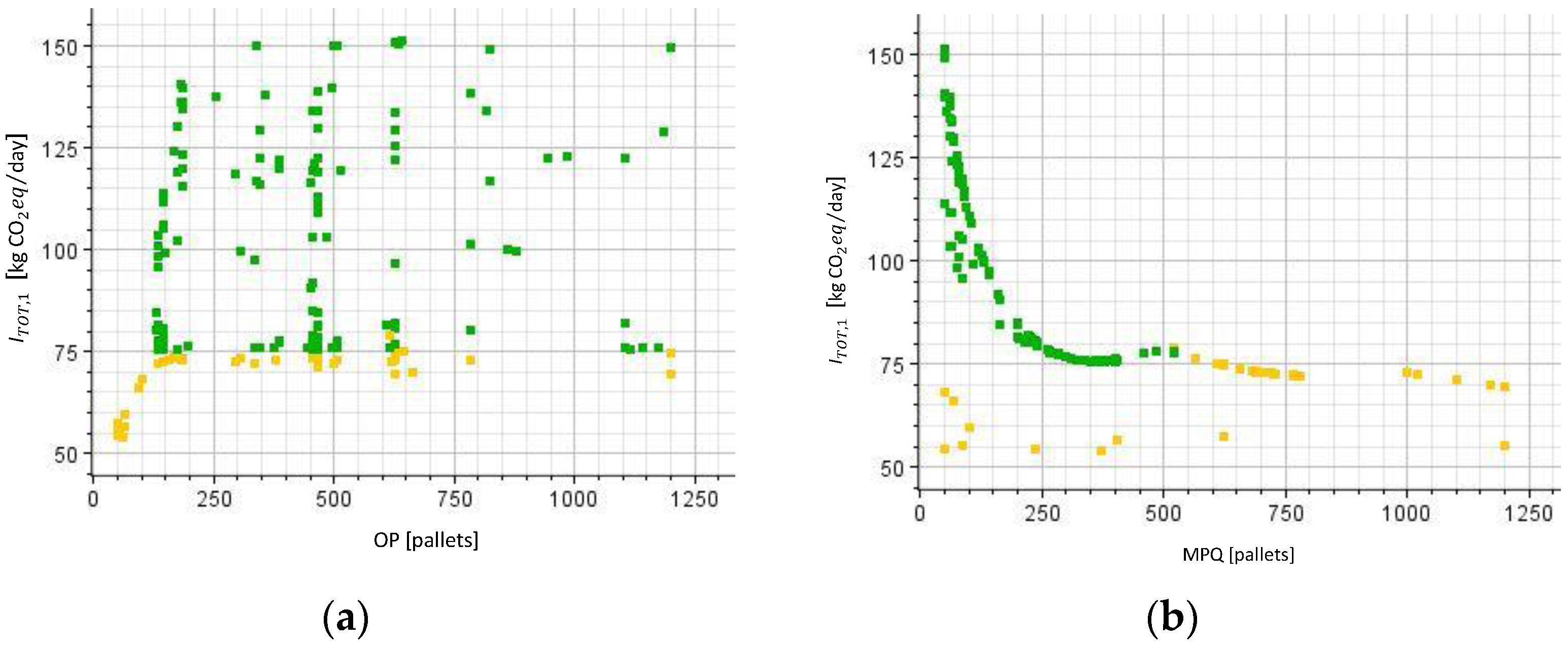
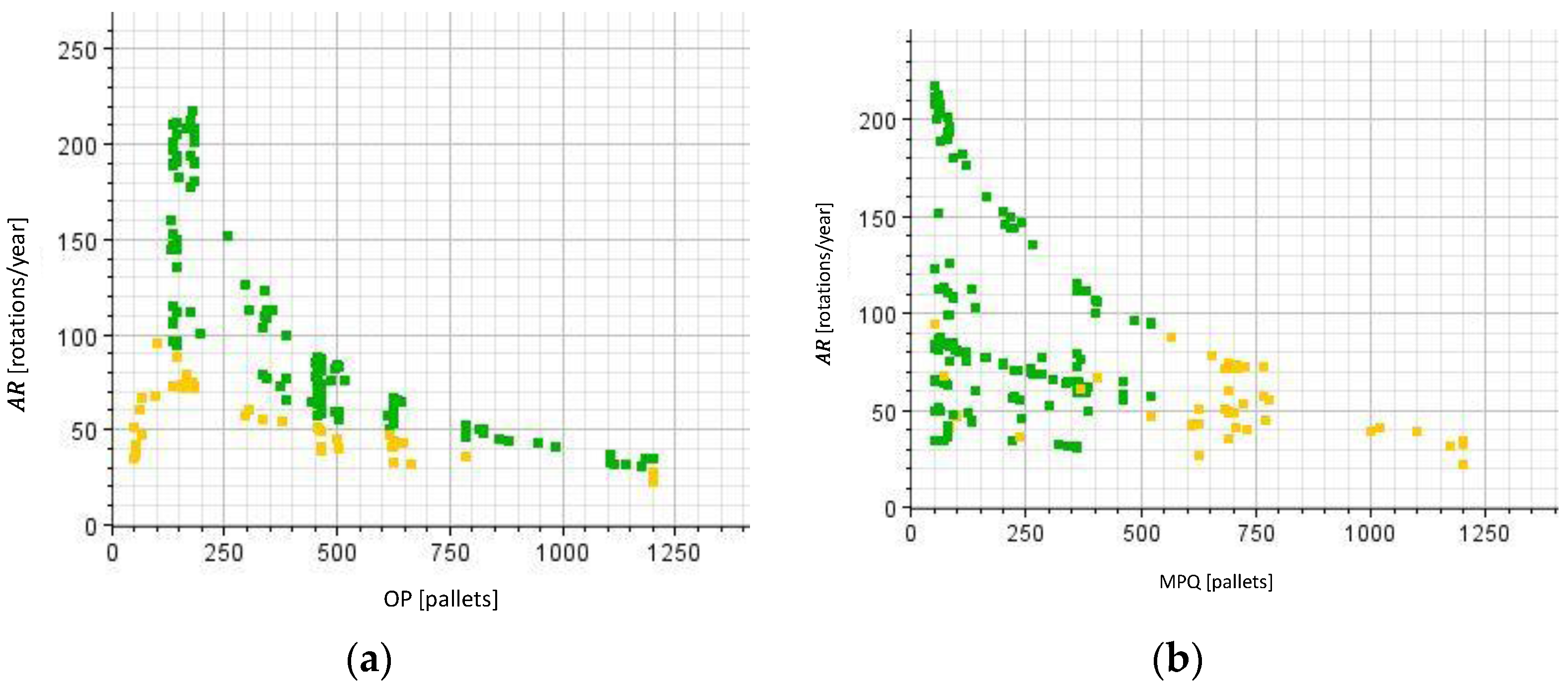
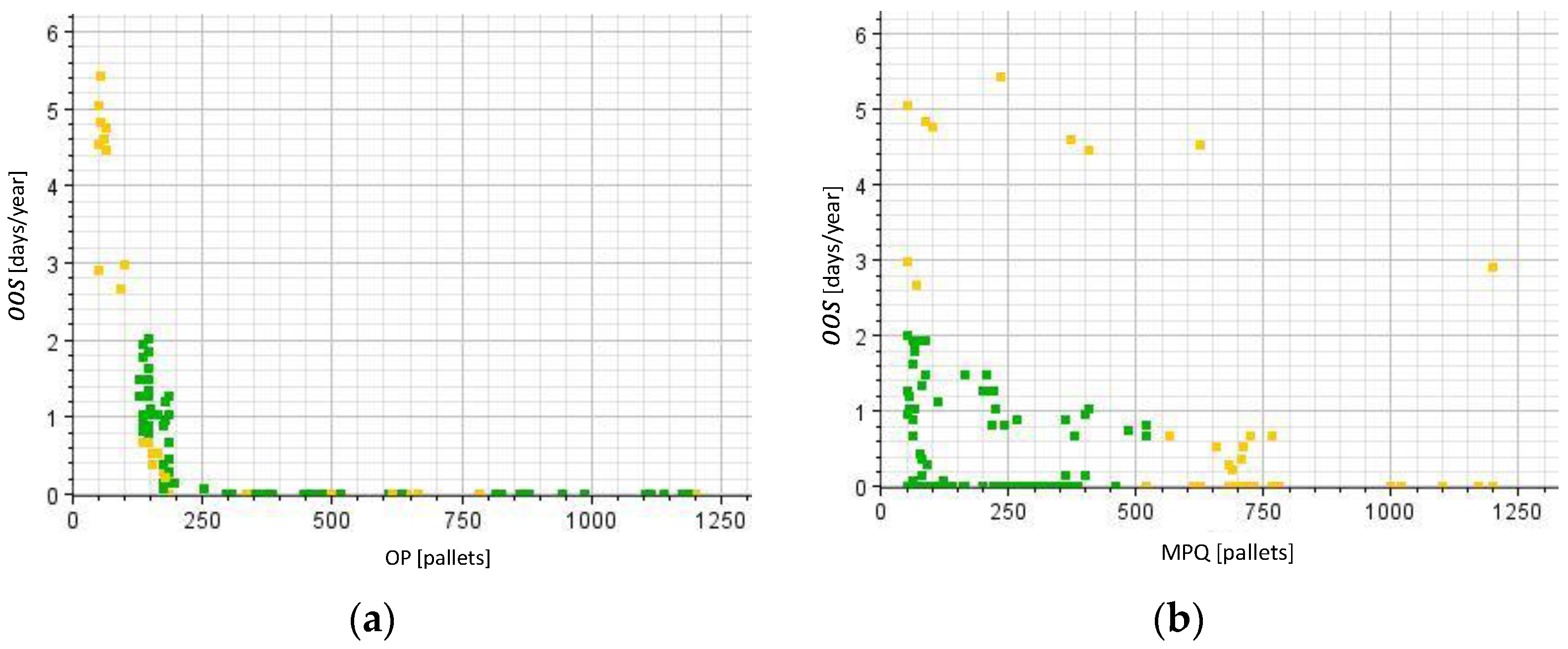
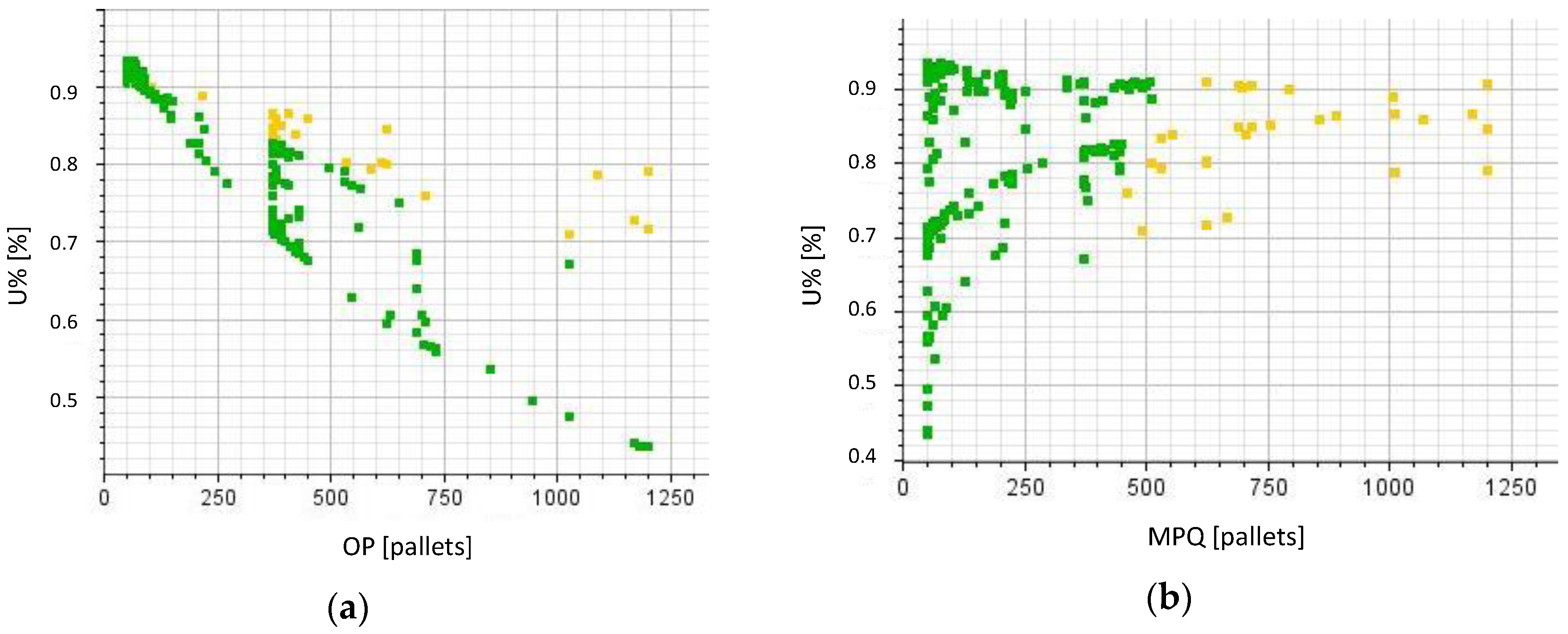
| Paper | Field | Sustainability Perspective | Methodology | Main Results | |
|---|---|---|---|---|---|
| Environmental | Economic | ||||
| Georgiadis and Besiou [30] | Waste of electric and electronic equipment in CLSC | x | x | Extension of a system dynamics-based model | The production of recycled materials of high quality improves the economical sustainability and the availability of natural resources |
| Gao and Ryan [31] | Document-office company operating in the Iberian market | x | x | Network design | Suggestions to balance the trade-offs between usual costs and the impact of carbon emission regulations |
| Shi and Min [32] | Supply chain centralization/decentralization | x | Modelling framework | Evaluation of the impact of supply chain centralization or decentralization strategies and of the relationships between government subsidy and fee on these strategies | |
| Alfonso-Lizarazo et al. [12] | Palm oil CLSC | x | Mathematical model | Impact of the simultaneous analysis of direct and reverse flows on the net economic profit of the CLSC | |
| Hasanov et al. [33] | Economic value and energy content of products | x | Novel modelling framework | Suggestions for a SC model that takes into account energy, transportation and disposal costs | |
| Chen et al. [34] | Crystalline solar energy industry | x | x | Deterministic multi-objective mixed integer programming model | Suggestions for capacity expansion, technology selection, supply chain design, factory location options and capacity allocation |
| Chen et al. [35] | Ink-and-toner cartridge delivering and recycling in Hong Kong | x | Mix integer linear programming model | Suggestion for integration of forward and reverse flows | |
| Garg et al. [36] | Geyser manufacturer CLSC | x | Interactive multi-objective programming approach algorithm | The inflow of returns with better recovery options substantially influences the economic benefit for business by increasing the demand for new products in first customer markets | |
| Alimorandi et al. [37] | CLSC | x | A fuzzy mixed integer linear programming model | Suggestions for a new design of supply chain network in which waste of materials is minimized and the new raw materials are necessary only when the used products may not be recovered | |
| Govindan et al. [38] | Case study from an electrical manufacturing industry | x | x | Multi-objective mixed integer mathematical problem | Suggestions to enhance manufacturing sustainability |
| Bottani et al. [25] | Manufacturer of fast moving consumer goods operating in the North of Italy | x | Mathematical model reproduced on a Microsoft Excel™ simulator | Suggestions for asset management strategies that minimize the total cost of the CLSC | |
| Dutta et al. [39] | CLSC of electronics products category | x | Recovery framework | Considerations about the profitability of the system as a function of the probability of product acceptance. | |
| Present study | Manufacturer of fast moving consumer goods operating in the North of Italy | x | x | Mathematical model reproduced on a Microsoft Excel™ simulator | Suggestions to minimize the environmental impact of the reverse logistics activities of RTI in a CLSC |
| Symbol | Description | Unit of Measurement |
|---|---|---|
| Indexes | ||
| i | delivery point (i = 1, … 7) | - |
| n | truck (n = 1, …ntruck) | - |
| t | simulation day (t = 0, … Ndays) | - |
| e | type of environmental emission (e = 1 for CO2; e = 2 for NOx; e = 3 for SOx) | - |
| Subscripts | ||
| L, D | lost or damaged pallets | - |
| r, s, p_u, p_r | recovery, shipment, urgent purchase, regular purchase | - |
| Tot | Total | - |
| DP | delivery point | - |
| A | Company A | - |
| Prov | pallet provider | - |
| Superscripts | ||
| P | “physical” | - |
| T | “theoretical” | - |
| Simulation parameters | ||
| Ndays | simulation duration | (days) |
| Delivery point parameters | ||
| order issued | (pallets) | |
| amount of assets retrieved | (pallets) | |
| , | percentage of assets lost and damaged | (%) |
| distance between delivery point and Company A | (km) | |
| Company A parameters | ||
| Ndays/year | working days per year | (days) |
| amount of assets shipped to delivery point | (pallets) | |
| , | physical and theoretical stock of assets | (pallets) |
| , | amount of assets purchased through a regular or urgent order | (pallets) |
| amount of proprietary assets | (pallets) | |
| distance from Company A to the pallet provider | (km) | |
| OP | order point | (pallets) |
| MPQ | minimum picked quantity (minimum amount of assets to be collected through retrieving operations) | (pallets) |
| Environmental parameters | ||
| CO2 emissions of a lost/damaged pallet | ||
| LF | load factor of a truck | (%) |
| IFLTe | emissions type e of a full load truck | (/km) |
| Other parameters | ||
| amount of palletized SKUs that can be loaded on a truck during shipment and retrieving | (pallets/truck) |
| Parameter | Numerical Value | Measurement Unit | Source |
|---|---|---|---|
| 260 | (days) | Company A | |
| = | 500 | (pallets) | Company A |
| 2.5% | - | Company A | |
| 1% | - | Company A | |
| 362 (i = 1); 358 (i = 2); 606 (i = 3); 352 (i = 4); 232 (i = 5); 934 (i = 6); 632 (i = 7) | (km) | Company A | |
| 38 | (km) | Company A | |
| 500 | (pallets/truck) | Company A | |
| 33 | (pallets/truck) | Company A | |
| 7.16 | [44] | ||
| 0.699 | (kg /km) | [42] | |
| 0.21 × 10−3 | (kg NOx/km) | [42] | |
| 0.08 × 10−3 | (kg SOx/km) | [42] |
| Decision Variables | Strategic KPIs | CO2 eq. (kg/day) | NOx (g/day) | SOx (g/day) | ||||||||||||||||
|---|---|---|---|---|---|---|---|---|---|---|---|---|---|---|---|---|---|---|---|---|
| Configuration ID | OP | MPQ | OOS | AR | U% | PA | ||||||||||||||
| 154 | 175 | 360 | 0.15 | 111.63 | 87.15 | 2047 | 42.76 | 0.23 | 28.90 | 3.61 | 75.50 | 12.80 | 0.07 | 1.08 | 14.00 | 4.80 | 0.03 | 0.14 | 5.33 | 179.28 |
| 262 | 195 | 400 | 0.15 | 100.80 | 86.85 | 2253 | 43.69 | 0.23 | 28.90 | 3.61 | 76.43 | 13.10 | 0.07 | 1.08 | 14.27 | 5.00 | 0.03 | 0.14 | 5.43 | 184.07 |
| 196 | 335 | 360 | 0.00 | 79.372 | 82.78 | 2205 | 43.05 | 0.23 | 28.90 | 3.61 | 75.79 | 12.90 | 0.07 | 1.08 | 14.08 | 4.90 | 0.03 | 0.14 | 5.36 | 184.31 |
| 237 | 345 | 370 | 0.00 | 76.41 | 82.23 | 2262 | 43.07 | 0.23 | 28.90 | 3.61 | 75.81 | 12.90 | 0.07 | 1.08 | 14.09 | 4.90 | 0.03 | 0.14 | 5.36 | 184.47 |
| 170 | 375 | 360 | 0.00 | 73.19 | 81.46 | 2228 | 43.18 | 0.23 | 28.90 | 3.61 | 75.92 | 12.90 | 0.07 | 1.08 | 14.13 | 4.90 | 0.03 | 0.14 | 5.38 | 185.28 |
| Decision Variables | Strategic KPIs | CO2 eq. (kg/day) | NOx (g/day) | SOx (g/day) | ||||||||||||||||
|---|---|---|---|---|---|---|---|---|---|---|---|---|---|---|---|---|---|---|---|---|
| Configuration ID | OP | MPQ | OOS | AR | U% | PA | ||||||||||||||
| 209 | 145 | 215 | 0.82 | 149.79 | 88.29 | 1467 | 48.17 | 0.23 | 28.9 | 3.61 | 80.91 | 14.47 | 0.07 | 1.08 | 15.62 | 5.51 | 0.03 | 0.14 | 5.95 | 202.03 |
| 61 | 145 | 240 | 0.82 | 147.05 | 88.21 | 1500 | 46.69 | 0.23 | 28.9 | 3.61 | 79.43 | 14.02 | 0.07 | 1.08 | 15.18 | 5.34 | 0.03 | 0.14 | 5.78 | 195.72 |
| 246 | 175 | 120 | 0.07 | 177.05 | 84.9 | 972 | 69.32 | 0.23 | 28.9 | 3.61 | 102.06 | 20.83 | 0.07 | 1.08 | 21.97 | 7.93 | 0.03 | 0.14 | 8.37 | 288.01 |
| 154 | 175 | 360 | 0.15 | 111.63 | 87.15 | 2047 | 42.76 | 0.23 | 28.9 | 3.61 | 75.5 | 12.80 | 0.07 | 1.08 | 14.00 | 4.80 | 0.03 | 0.14 | 5.33 | 179.23 |
| 91 | 145 | 265 | 0.89 | 135.51 | 88.19 | 1714 | 44.99 | 0.23 | 28.9 | 3.61 | 77.73 | 13.52 | 0.07 | 1.08 | 14.67 | 0.14 | 0.03 | 0.14 | 5.59 | 188.56 |
| Decision Variables | Strategic KPIs | CO2 eq. (kg/day) | NOx (g/day) | SOx (g/day) | ||||||||||||||||
|---|---|---|---|---|---|---|---|---|---|---|---|---|---|---|---|---|---|---|---|---|
| Configuration ID | OP | MPQ | OOS | AR | U% | PA | ||||||||||||||
| 130 | 135 | 60 | 1.93 | 210.9 | 89.28 | 967 | 70.64 | 0.23 | 28.9 | 3.61 | 103.38 | 21.22 | 0.07 | 1.08 | 22.38 | 8.09 | 0.03 | 0.14 | 8.52 | 299.89 |
| 62 | 145 | 60 | 1.63 | 211.25 | 87.83 | 919 | 79.03 | 0.23 | 28.9 | 3.61 | 111.77 | 23.74 | 0.07 | 1.08 | 24.90 | 9.05 | 0.03 | 0.14 | 9.48 | 335.18 |
| 78 | 135 | 85 | 1.93 | 196.68 | 90.39 | 1051 | 63.12 | 0.23 | 28.9 | 3.61 | 95.86 | 18.96 | 0.07 | 1.08 | 20.12 | 7.22 | 0.03 | 0.14 | 7.66 | 268.14 |
| 123 | 135 | 80 | 1.93 | 200.95 | 88.96 | 1030 | 68.1 | 0.23 | 28.9 | 3.61 | 100.84 | 20.46 | 0.07 | 1.08 | 21.61 | 7.79 | 0.03 | 0.14 | 8.23 | 288.14 |
| 191 | 145 | 50 | 2.01 | 211.93 | 87.7 | 886 | 80.97 | 0.23 | 28.9 | 3.61 | 113.71 | 24.33 | 0.07 | 1.08 | 25.48 | 9.27 | 0.03 | 0.14 | 9.71 | 344.01 |
© 2018 by the authors. Licensee MDPI, Basel, Switzerland. This article is an open access article distributed under the terms and conditions of the Creative Commons Attribution (CC BY) license (http://creativecommons.org/licenses/by/4.0/).
Share and Cite
Bottani, E.; Casella, G. Minimization of the Environmental Emissions of Closed-Loop Supply Chains: A Case Study of Returnable Transport Assets Management. Sustainability 2018, 10, 329. https://doi.org/10.3390/su10020329
Bottani E, Casella G. Minimization of the Environmental Emissions of Closed-Loop Supply Chains: A Case Study of Returnable Transport Assets Management. Sustainability. 2018; 10(2):329. https://doi.org/10.3390/su10020329
Chicago/Turabian StyleBottani, Eleonora, and Giorgia Casella. 2018. "Minimization of the Environmental Emissions of Closed-Loop Supply Chains: A Case Study of Returnable Transport Assets Management" Sustainability 10, no. 2: 329. https://doi.org/10.3390/su10020329






